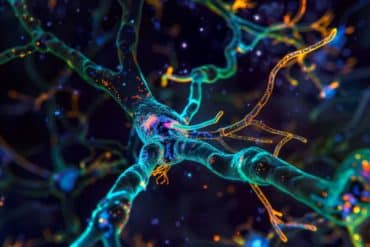Summary: Researchers have identified a new target in the brain that underpins the freezing response associated with anxiety and fear. The findings could provide a new drug target for anxiety-related disorders.
Source: University of Bristol
A new target in the brain which underpins the eliciting of anxiety and fear behaviors such as “freezing” has been identified by neuroscientists.
The University of Bristol researchers say the discovery of a key pathway in the brain, to be published in the journal eLife, offers a potential new drug target for treating anxiety and psychological disorders, which affect an estimated 264-million people worldwide.
Existing anxiety-reducing drugs are not always effective for all patients and often have unwanted side effects. Understanding the brain networks and mechanisms which underlie fear and anxiety may offer a new approach to developing better treatments for anxiety disorders.
Neuroscientists from Bristol’s School of Physiology, Pharmacology and Neuroscience, sought to investigate how the brain’s cerebellum, which is connected to many brain regions associated with survival networks, influences activity in another area of the brain called the periaqueductal gray (PAG). This PAG area lies at the hub of central networks that co-ordinate survival mechanisms including fear-evoked coping responses such as “freezing.”
To investigate this, researchers fitted animal models with electrodes to record activity within the brain’s PAG region and applied a conditioning task, whereby an auditory tone is paired with a small foot shock, eliciting the formation of a “fear memory” and freezing, a behavioral index of fear. The team showed that within the brain’s PAG area, a subset of brain cells increased their responsiveness to the conditioned tone, consistent with encoding a fear memory.

However, when cerebellar output was altered during conditioning, the subsequent timing of fear-related neuronal activity in the PAG became less precise and the duration of fear-related freezing behavior was increased confirming that cerebellar-periaqueductal gray interactions contribute to fear conditioning processes. The team showed that the manipulation of a direct cerebellar-PAG pathway, also caused impairments in fear conditioned freezing and ultrasonic vocalizations.
The study’s lead authors, Dr. Charlotte Lawrenson and Dr. Elena Paci, explain: “Until now, little was understood about how the cerebellum modulates neuronal activity in other brain regions, especially those related to fear and anxiety. Importantly, our results show that the cerebellum is part of the brain’s survival network that regulates fear memory processes at multiple timescales and in multiple ways; raising the possibility that dysfunctional interactions in the brain’s cerebellar-survival network may underlie fear-related disorders and comorbidities.”
The study’s findings provide new insights into the way the PAG encodes fear memory and also provides evidence that the cerebellum is an additional key structure in the list of brain regions that contribute to the fear/anxiety network and offers a novel target for treating psychological conditions including post-traumatic stress disorder.
About this anxiety and fear research news
Author: Press Office
Source: University of Bristol
Contact: Press Office – University of Bristol
Image: The image is in the public domain
Original Research: Open access.
“Cerebellar modulation of fear behavior and memory encoding in the PAG” by CL Lawrenson et al. eLife
Abstract
Cerebellar modulation of fear behavior and memory encoding in the PAG
The pivotal role of the periaqueductal grey (PAG) in fear learning is reinforced by the identification of neurons in rat ventral PAG (vPAG) that encode fear memory through signalling the onset and offset of an auditory conditioned stimulus during presentation of the unreinforced conditioned tone during retrieval. Some units only display CS+ onset or offset responses and the two signals differ in extinction sensitivity, suggesting they are independent of each other.
In addition, understanding cerebellar contributions to survival circuits is advanced by the discovery that: (i) reversible inactivation of the medial cerebellar nucleus (MCN) during fear consolidation leads in subsequent retrieval to: (a) disruption of the temporal precision of vPAG offset, but not onset responses to the unreinforced conditioned tone, and (b) an increase in duration of freezing behaviour. And (ii) chemogenetic manipulation of the MCN-vPAG projection during fear acquisition: (a) reduces the occurrence of fear- related ultrasonic vocalisations and (b) during subsequent retrieval, slows the extinction rate of fear- related freezing.
These findings show that the cerebellum is part of the survival network that regulates fear memory processes at multiple timescales and in multiple ways; raising the possibility that dysfunctional interactions in the cerebellar-survival network may underlie fear-related disorders and comorbidities.






